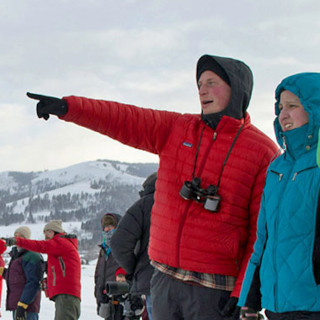Student Spotlight: Joseph Denhert
In this episode, hear from Joseph Denhert, a graduate student in Community and Environmental Planning at the W.A. Franke College of Forestry and Management. Joseph talks about how he connects to a place through its rivers, his stream assessment work for the Clark Fork Coalition, and his thesis research, which uses hand-held cameras to create 3D snapshots of stream restoration efforts.
Episode Extras
A New York Times write up about Joseph and his wife, Julie.
Story Transcript
I don't really connect with a place by like going to its restaurants or figuring out the downtown street connections, I connect with it by pulling out a map, putting it on the hood of my truck and finding a blue line that I haven't been to. So, I must have spent a lot of money just driving around to every single stream and river I could within a two-hour radius of here. And I fell in love with it.
My name's Joe Denhert. I'm in the Community and Environmental Planning option within the W.A. Franke College of Forestry and Conservation. It's a master’s program in Geography with a focus in Community and Environmental Planning.
So, the Clark Fork Coalition has a stretch of stream along Dry Cottonwood Creek and the North Fork of Dry Cottonwood Creek that they've been collecting data on for quite a number of years. And they hire on some research assistants to come out and help collect data to measure the efficacy of their restoration efforts happening along those stretches of stream. So, I was one of the team of seven. They trained us on how to estimate the amount of vegetation, how to identify invasive vs. non-invasive, how to look at signs for browsing from livestock, hummocking from livestock, and then where the restoration efforts were. And then we had to walk the stream and collect these data and catalog them. And then they use those data to compare to previous year’s data to see how effective their efforts were at preventing things like erosion, native habitat, tree loss, stuff like that. And, whenever I was doing that, I realized that was a pretty awesome thing that they were doing, but I wanted to know if there was a way to do it with less manpower and more technology.
The research I'm doing right now is really focused on providing a tool to folks that don't have access to tons of money that are doing stream restoration work. That might be nonprofits, it could be individuals working under a budget for whatever organization. And the elevator pitch of it all is: it's using handheld photogrammetry as a riparian and stream assessment and monitoring tool here along small creeks in Western Montana. You know, if you could basically take like a snapshot, a 3D snapshot, not just a 2D picture, but if you could have a 3D snapshot of that stream at the time of survey, I just had this idea of like, wow, that'd be really valuable. So, to break that down a little bit, I tested iPhone, GoPro and just a Sony DSLR camera against one another to see the kind of point clouds and products they could create within a software program called Agisoft Metashape. You know, a lot of it is you're out there estimating approximately how much of these banks are covered by vegetation? Approximately how much of this is hummocking? What's the wetted width? What's the depth? What's the bank incision? What's the substrate size? All of these characteristics and, it's really putting a tool in the hands of people that are out there trying to assess the efficacy of restoration efforts along these small streams.
I don't think that I'm Elon Musk or that I'm going to start like a crazy tech company that's going to revolutionize the way that we plan for environmental impact or extract natural resources. But I do believe that I possess, and I've been given, you know, the opportunities in life to like make a difference in my community through my action. And a real way that I see that happening is through planning, whether that's planned development, whether that's just being a grunt and evaluating subdivision proposals for the next three years. I'm okay putting in the time it takes to get to where I need to go. And where I need to go, personally, is like making a difference in my community.
